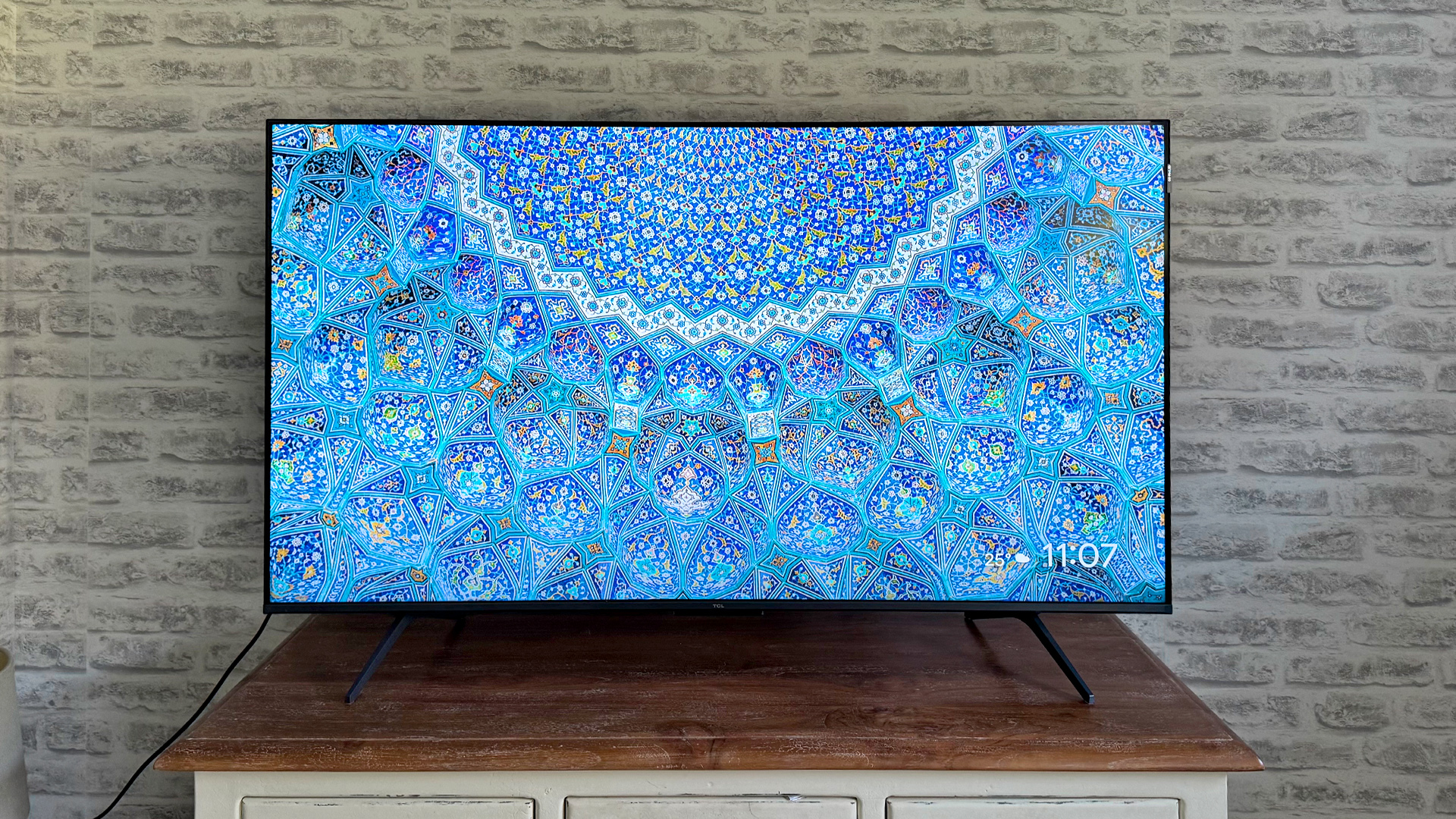Samsung 2021 TV lineup: everything you need to know
MicroLEDs, 'Neo QLEDs', standard QLEDs, LCD models and 8K TVs feature in the Samsung 2021 TV range

This is looking like a big year for Samsung TVs. Having somewhat trodden water in 2020, the company appears to be striding forward in 2021, with highlights that include consumer MicroLED models, 'Neo QLEDs' with astonishingly small Mini LEDs, and a new version of the One Connect box that can be attached to the TV's pedestal stand.
Each of these overriding themes of Samsung in 2021 is outlined just below this section, and below that we've outlined the entire model lineup with all of the latest information available. Fair warning, though; Samsung is notorious for its confusing model numbers and lineups, particularly between regions, and this year is worse than ever. You'll see what we mean when you get there.
Before we get into the nitty-gritty, though, a quick overview of 2021 model designations: 2021 is year 'A' for Samsung, whereas 2020 was year 'T' (as in 'Q70T') and 2019 was 'R' (as in Q70R). You can therefore expect QLED model numbers to end in an 'A' (Q70A, for example), and LCD models to have one before their series designation (e.g. 'AU8000').
Finally, you'll also see an 'N' in some QLED model numbers – 'QN85A', for example. This denotes the Neo QLED (i.e. Mini LED) models from those that utilise standard LED backlights.
Samsung MicroLED TV

While Samsung has been talking about MicroLED for quite some time now, 2021 has finally seen the launch of consumer models.
For the unfamiliar, MicroLED is a next-gen TV technology that essentially takes the best qualities of OLED and removes more or less all of its shortcomings. Like OLED, each pixel is self-emissive, so one can be completely black while those next to it can be bright white or a vibrant colour, creating incredible contrast.
MicroLEDs can actually go much brighter than OLEDs, though, theoretically resulting in even more spectacular contrast. Samsung is quoting a peak brightness rating of 2000 nits in regard to this new MicroLED TV, which makes it around twice as bright as even the best OLEDs. What's more, unlike OLED TVs, which use organic materials ('OLED' stands for 'Organic Light Emitting Diode'), MicroLEDs are inorganic, so don't degrade and can't suffer from image retention or burn-in.
The latest hi-fi, home cinema and tech news, reviews, buying advice and deals, direct to your inbox.
The new consumer MicroLED TV will be available in four sizes: 76 inches, 88 inches, 99 inches and a huge 110 inches. Each model comes pre-assembled as a complete flatscreen TV, unlike commercial MicroLEDs, which come as smaller modules that can be assembled in various configurations.
Interestingly, given the huge sizes and next-gen credentials we're talking about, this new consumer MicroLED TV boasts 'only' a 4K resolution. That's because the size of the individual MicroLEDs (each of which represents a single pixel, remember) means there are physical limitations to pixel density (how many pixels can be crammed into each inch of screen). In other words, MicroLEDs will have to get even smaller before MicroLED TVs become available at smaller sizes and higher resolutions.
Of course, what you really want to know is how much Samsung's new consumer MicroLED costs. Unfortunately, while Harrods in London now has a display model and is taking orders for the 110-inch MNA110MS1, it's so far not been at all forthcoming on the price. That said, Business Korea claims that it's expected to be priced over 100-million won, which translates to roughly £70,000 ($90,000, AU$125,000).
Neo QLEDs with Mini LED backlighting
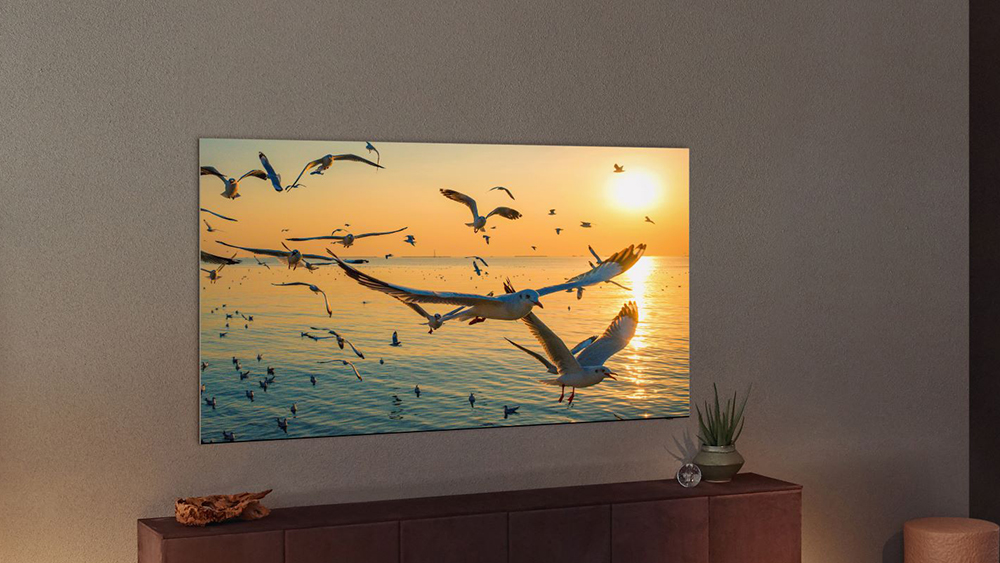
While MicroLED remains the preserve of the super-rich for now, Samsung is bringing Mini LED tech to its premium QLEDs, which it refers to as 'Neo QLEDs'.
Samsung explains that the majority of a typical LED's size is made up of its protective packaging and light-guiding lens, both of which it's done away with for its so-called 'New LEDs'. Not only that, it's also miniaturised the LEDs themselves, to quite astonishing effect.
As part of a video presentation, Samsung demonstrated to us the degree of difference by putting a petri dish containing 100 traditional backlight LEDs next to another containing its New LEDs. The traditional LEDs are big and clear, filling their dish, while the New LEDs genuinely look like nothing more than sparkly grains of sand. Samsung says the New LEDs are a fortieth the size of traditional LEDs, but even that doesn't convey how incredibly tiny they appear.
Instead of a lens, Samsung's New LED backlights use a new 'micro layer' that guides the light through the quantum dots (which provide the set's colours). The result is apparently no light leakage or blooming, and because the New LEDs are so much smaller, significantly more of them can be packed in – one slide we saw referred to "ten-times greater density". Given that Samsung's top 2020 model, the Q950TS, is said to have around 500 dimming zones (Samsung doesn't publish specific numbers), we're potentially talking about around 5000 zones for these top Neo QLEDs. The number of dimming zones will vary by model, though.
Of course, Samsung isn't the first TV brand to utilise Mini LEDs, but the company claims that its are the smallest and most precise out there – mind you, that was before LG announced its own Mini LED TVs.
Neo Quantum Processor
Of no surprise at all is that Samsung is introducing a new processor for its 2021 TVs. This 'Neo Quantum Processor' brings with it, among other things, more precise dimming and a local power distribution feature that sends power to the brightest areas of the picture and away from the darker parts. It also works in conjunction with a sensor integrated into the TV's frame to adjust brightness and contrast in response to ambient lighting conditions.
In Samsung's 2021 8K TVs, the Neo Quantum Processor also utilises something that Samsung calls 'Multi-Intelligence Deep Learning' to improve upscaling. The company explains that in 2020 its deep learning produced a single neural network, but in 2021 the system can produce up to 16 neural networks that enhance resolution and overall video quality. Essentially, it seems that each of the neural networks specialises in a different area of picture quality, then a Neural Analyser selects the most appropriate for the specific content being played.
Extension of Object-Tracking Sound (OTS)
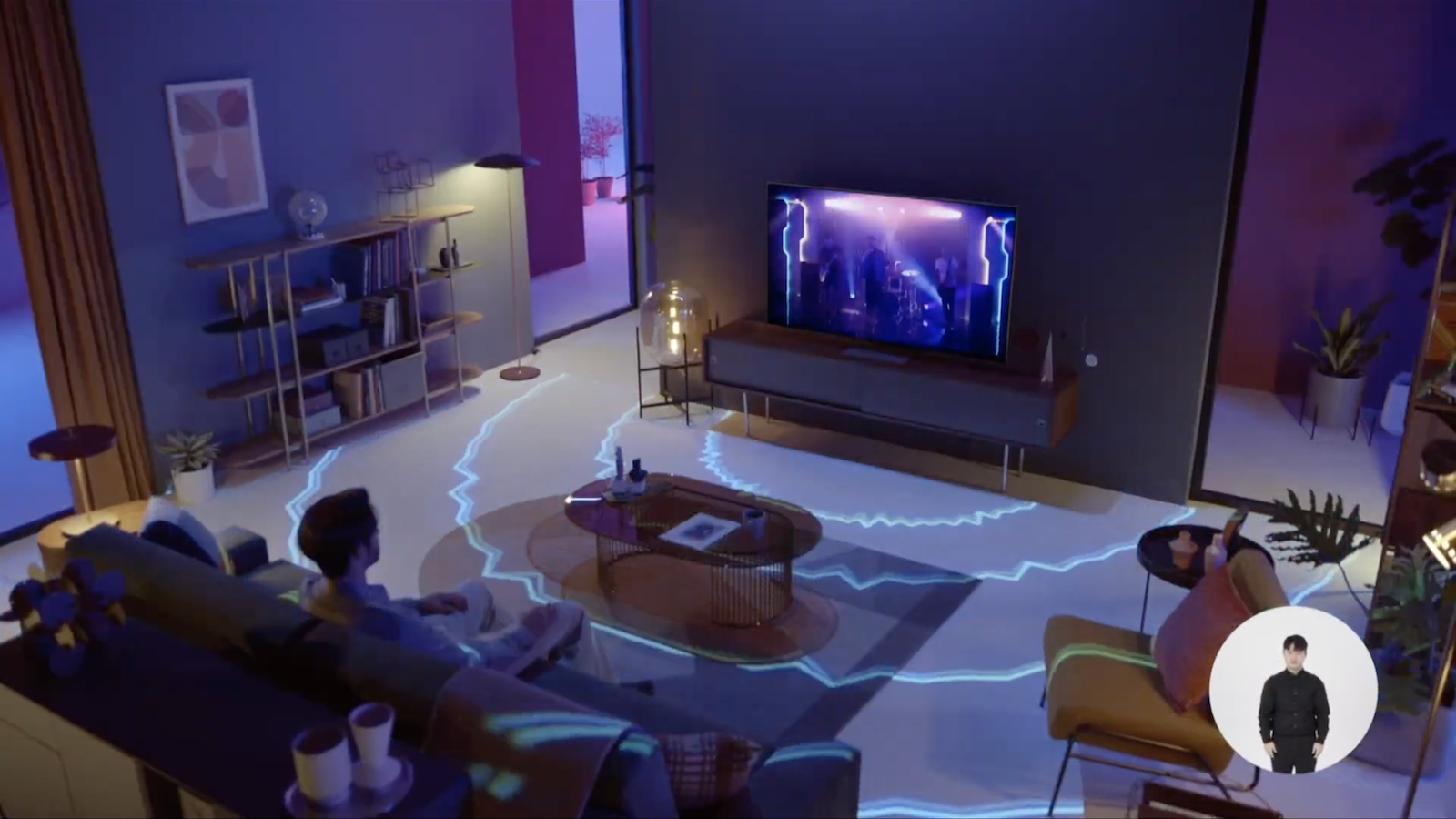
Samsung introduced Object-Tracking Sound with last year's QLEDs, but this year it's been expanded, both in terms of the models it covers and the number of speakers involved.
There are now four versions of OTS, with the new OTS Lite at the bottom and OTS Pro at the top. Each version differs in terms of the number of speakers involved.
OTS Lite consists of two physical speakers at the bottom and two 'virtual speakers' that provide height. It's available on the most premium LCD models. The standard version of OTS adds physical speakers to the top of the set, OTS+ adds side-firing speakers, and OTS Pro adds extra tweeters, taking the complete speaker array up to a total of 6.2.2 channels.
Every version of OTS is designed to fill a room as much as possible and provide three-dimensional tracking of effects, very much along the lines of virtualised Dolby Atmos. Some models also feature something called 'SpaceFit', which is an enhanced version of the company's existing Adaptive Sound tech that adapts audio performance to the TV's surroundings.
All models also appear to feature Active Voice Amplifier, which is designed to actively detect external noise and boost the volume of the voice track so that dialogue is more audible, and Q Symphony, which allows the TV’s speakers to work in conjunction with a connected Samsung soundbar – there's a whole new range of those in 2021, of course, including the recently reviewed HW-Q800A.
Design, new One Connect and solar remote control
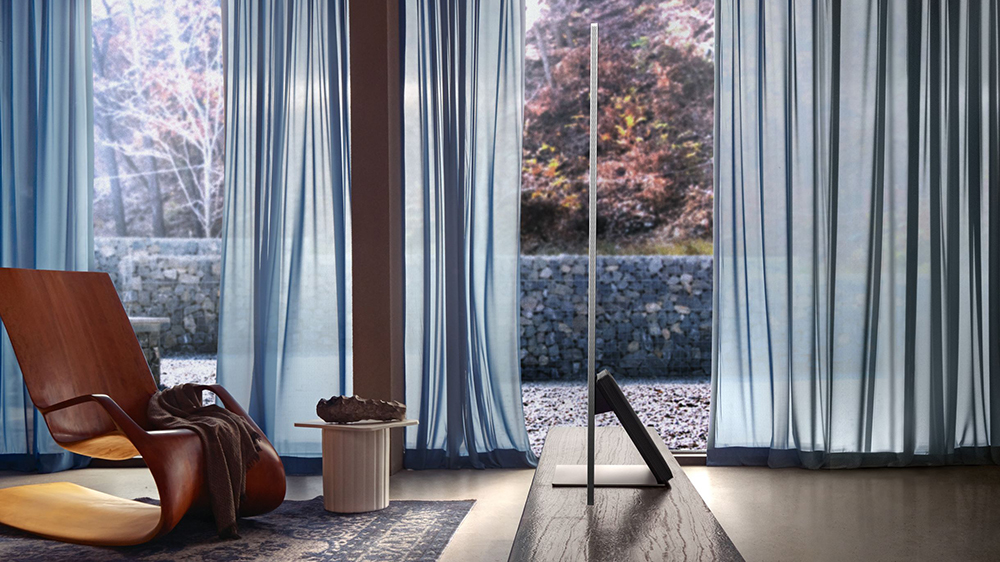
Like many of us humans, Samsung's TVs appear to be on a slimness drive in 2021. The top 8K models were already just 15mm thick, so it's little surprise that they're not getting any slimmer, but all of the 4K models specifically mentioned so far have a thickness of 2.5cm. That represents a 1cm reduction in thickness for the top QN90A (compared with the Q90T), and a slimming-down of over 3cm for lower models such as the Q70A and Q60A QLEDs, and the AU9000 LCD.
If your pockets are deep enough for the flagship QN900A 8K model, you'll also get Samsung's Infinity Screen, which is an essentially bezel-less, edge-to-edge display, as seen with 2020's Q950TS.
We were worried about the future of Samsung's One Connect system, which sees all connections (and even power) routed through an external processing box that can be placed out of sight, but Samsung has in fact launched a new version of One Connect for 2021. The big news is that the new One Connect box is significantly smaller and slimmer than the one it replaces, to the extent that it can be attached to the rear of the stand if required.
Those who are wall-mounting (or who simply want to move cable-clutter as far away from the display as possible) can still place the new unit on a separate shelf or in a cupboard, and its new shape and size should make it far easier to find a home for.
The 2021 One Connect is available on the QN95A 4K set and all 8K models.
Samsung has also developed a light-powered remote control for 2021. It looks very similar to the excellent One Remote of existing models, but there's a solar panel on the rear that enables it to be charged in the ambient light of an average living room. This 'Eco Remote Control' works really well and comes with all QLED models.
Gaming features
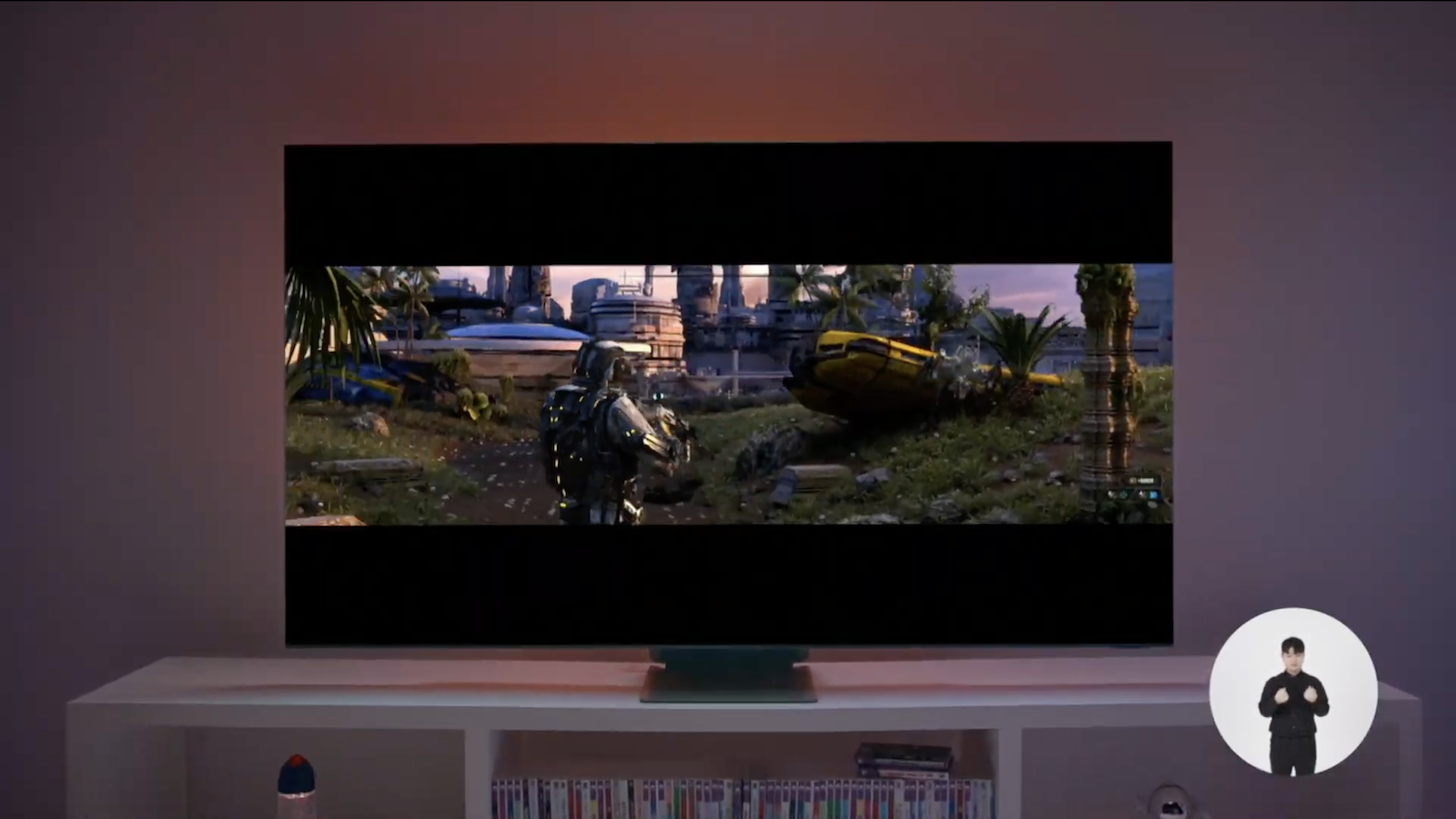
Samsung's long been at the forefront of gaming TV tech, and that remains the case in 2021. 4K@120Hz is supported on all models from the Q70A and up, VRR support includes Nvidia G-Sync and AMD FreeSync Premium Pro, ALLM and HGiG are both supported, and input lag is down to just 9.8ms.
Interestingly, Samsung is also promising support for 4K@120Hz on its AU8000 and AU9000 LCD models, even though they feature 60Hz panels. The company's calling this technology 'Motion Xcelerator Turbo', but it's not yet clear how it works beyond Samsung saying that it allows the models to refresh twice as fast. These models are getting AMD FreeSync certification, too – that's apparently a first for a 60Hz TV.
On top of all of that, Samsung is introducing something it's calling 'Super Ultrawide Gameview', which allows you to force the TV into ultra-wide aspect ratios, essentially simulating the experience of using an ultra-wide gaming monitor. This obviously involves big black bars filling in the screen's unused display area, so we're not sure how appealing it will really be, but time will tell.
One slight disappointment is that while next-gen HDMI 2.1 is supported by a lot of TVs in the 2021 range, most only get one such socket, with the others being lower-bandwidth HDMI 2.0s. To get a full complement of four HDMI 2.1 connections, you'll need to opt for one of the models that has the One Connect box. It only currently makes a difference for 4K@120Hz signals and therefore to those lucky enough to have both the PS5 and Xbox Series X (and/or a high-end gaming PC), but it's an undeniable minus point when compared to most LG OLEDs, which have had four HDMI 2.1 sockets since 2019.
Smart features
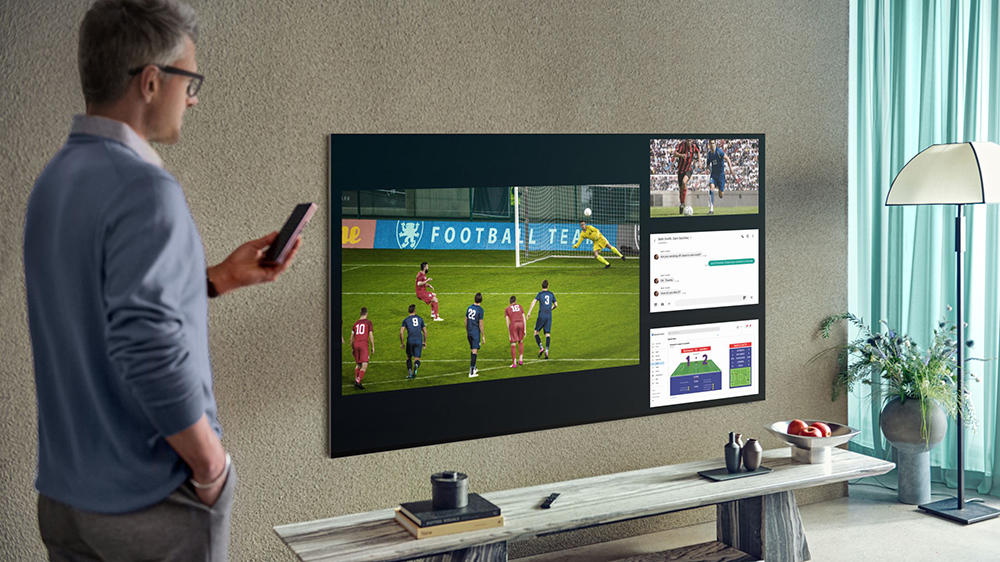
The Tizen smart platform itself has changed very little, but that's no bad thing – it was already the best in the business in terms of its app offering and usability.
That said, Samsung has seen its way to offer some pandemic-friendly features such as Google Duo for video calls and a Smart Trainer app, the latter of which is an extension of the existing Samsung Health platform. Taking full advantage of either involves buying an optional video camera, which can track you around the room in the vein of Facebook Portal.
Samsung is also extending its Multi-View feature, which allows you to display multiple sources at once in a split-screen format. It's going to be available on all models from the AU9000 upwards, with 4K models supporting two windows and 8K models supporting four. In our QN95A review we noted disappointing limitations to this feature, though – of the two windows, one has to be an external source and the other has to be an app, but currently only two apps (YouTube and wellness app called Calm) are supported, severely hampering its usefulness. Here's hoping more apps are made compatible in the near future.
Samsung 2021 TV range breakdown
So that's the overview of the technology behind Samsung's 2021 TV range, but what about specific models? We now have a pretty complete picture of the range in both the UK (and Europe) and US, and you'll find all the details below.
To reiterate something we said right near the top of this page – there are some very confusing discrepancies between the models available in different regions. Not only are some models exclusive to certain countries, which isn't a terribly new thing, some models (most notably the QN90A) have different specs depending on where you buy them. We've attempted to explain all of that below, but it's fair to say that Samsung hasn't been completely forthcoming with this information so there could still be differences that we're not yet aware of.
Samsung QN900A 8K Neo QLED TV

Samsung's very top QLED model for 2021 is the QN900A. This is, of course, an 8K model, and it features the new LED backlight.
Design-wise, it boasts the edge-to-edge Infinity Screen and a super-low profile 4mm pedestal stand, to which the new One Connect box can be attached. It's just 15mm thick, and the three-degree lean of the outgoing Q950TS has gone – this model stands straight up.
The QN900A is available to buy now in UK, US and Australia.
Samsung QN900A specs:
- Display type: Neo QLED
- Resolution: 8K
- Sizes: 65-inch, 75-inch, 85-inch
- One Connect: Yes
- Sound: OTS Pro (6.2.2ch, 80W)
- 4K@120Hz: Yes
- Ultra-Wide Viewing Angle: Yes
- Anti-Reflective Panel: Yes
- HDMI 2.1 sockets: 4
Samsung QN900A prices:
- QE65QN900A / QN65QN900A / QA65QN900A – £5999 / $5000 / AU$6799
- QE75QN900A / QN75QN900A / QA75QN900A – £7999 / $7000 / AU$9499
- QE85QN900A / QN85QN900A / QA85QN900A – £11999 / $9000 / AU$12,499
Samsung QN800A 8K Neo QLED TV
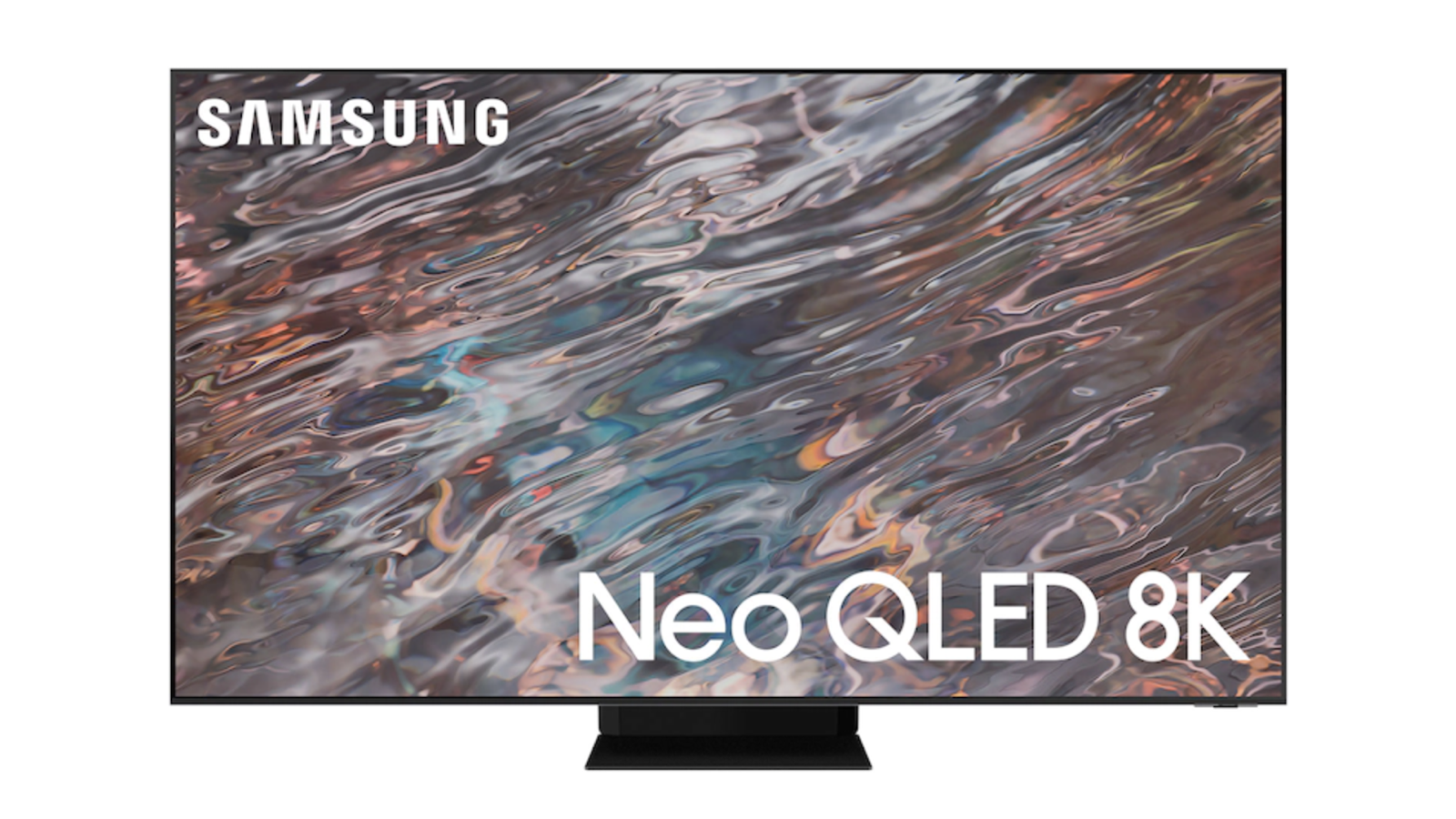
This step-down 8K model, the QN800A is largely the same as the QN900A above but with lower peak brightness, a sonic downgrade from OTS Pro to OTS+, and without the Infinity Screen. We expect it will have fewer dimming zones, too, although we haven't yet had that confirmed.
Like the QN900A, it's also available now in the UK, US and Australia.
Samsung QN800A specs:
- Display type: Neo QLED
- Resolution: 8K
- Sizes: 65-inch, 75-inch, 85-inch
- One Connect: Yes
- Sound: OTS+ (4.2.2ch, 70W)
- 4K@120Hz: Yes
- Ultra-Wide Viewing Angle: Yes
- Anti-Reflective Panel: Yes
- HDMI 2.1 sockets: 4
Samsung QN800A prices:
- QE65QN800A / QN65QN800A / QA65QN800A – £3999 / $3500 / AU$4999
- QE75QN800A / QN75QN800A / QA75QN800A – £5499 / $4800 / AU$6799
- QE85QN800A / QN85QN800A / QA85QN800A – £6999 / $6500 / AU$9499
Samsung QN700A 8K Neo QLED TV (UK-only)
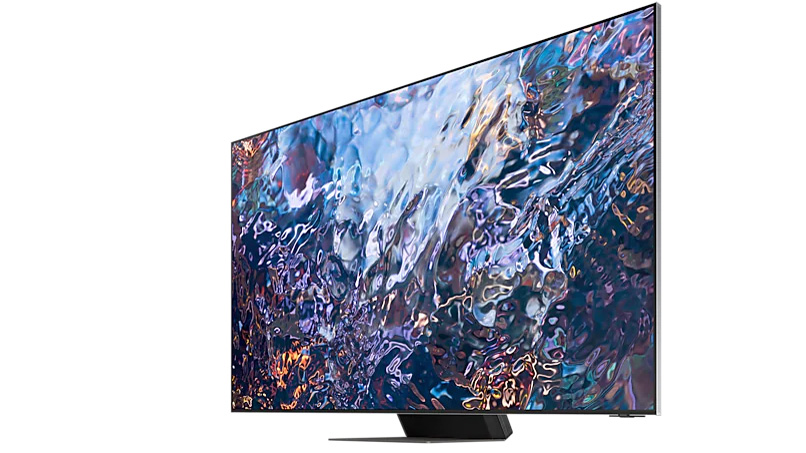
Officially unveiled much later than the models above, the QN700A is the entry-level 8K model in Samsung's 2021 TV range.
It utilises the less powerful Neo Quantum Processor Lite 8K and doesn't have any HDMI 2.1 sockets, but it otherwise looks very similar to the QN800A. There's every chance it will have fewer dimming zones, but Samsung rarely goes into detail on such things.
The QN700A is currently available to buy in the UK and will likely remain exclusive to Europe.
Samsung QE65QN700A specs:
- Display type: Neo QLED
- Resolution: 8K
- Sizes: 55-inch, 65-inch, 75-inch
- One Connect: Yes
- Sound: OTS+ (4.2.2ch, 70W)
- 4K@120Hz: No
- Ultra-Wide Viewing Angle: TBC
- Anti-Reflective Panel: Yes
- HDMI 2.1 sockets: No
Samsung QN800A prices:
- QE55QN700A – £2499
- QE65QN700A – £3499
- QE75QN700A – £4999
Samsung QN95A 4K Neo QLED TV (UK-only)

Samsung's top 4K model for 2021 is the QN95A, which is exclusive to the UK and Europe. It's the same as the (also European-exclusive) QN94A and the US and Australian QN90A (but not the UK QN90A) except it adds the One Connect box.
The addition of One Connect isn't just a boon to neatness – it also takes the number of HDMI 2.1 sockets from one to four, which could be a major consideration for gamers in particular.
We've now reviewed the 65-inch version of the QN95A, and exceptionally good it is, too. Read our Samsung QE65QN95A review.
Samsung QN95A specs:
- Display type: Neo QLED
- Resolution: 4K
- Sizes: 55-inch, 65-inch, 75-inch, 85-inch
- One Connect: Yes
- Sound: OTS+
- 4K@120Hz: Yes
- Ultra-Wide Viewing Angle: Yes
- Anti-Reflective Panel: Yes
- HDMI 2.1 sockets: 4
Samsung QN95A prices:
- QE55QN95A – £2199
- QE65QN95A – £2999
- QE75QN95A – £4499
- QE85QN95A – £5999
Samsung QN94A 4K Neo QLED TV (UK-only)
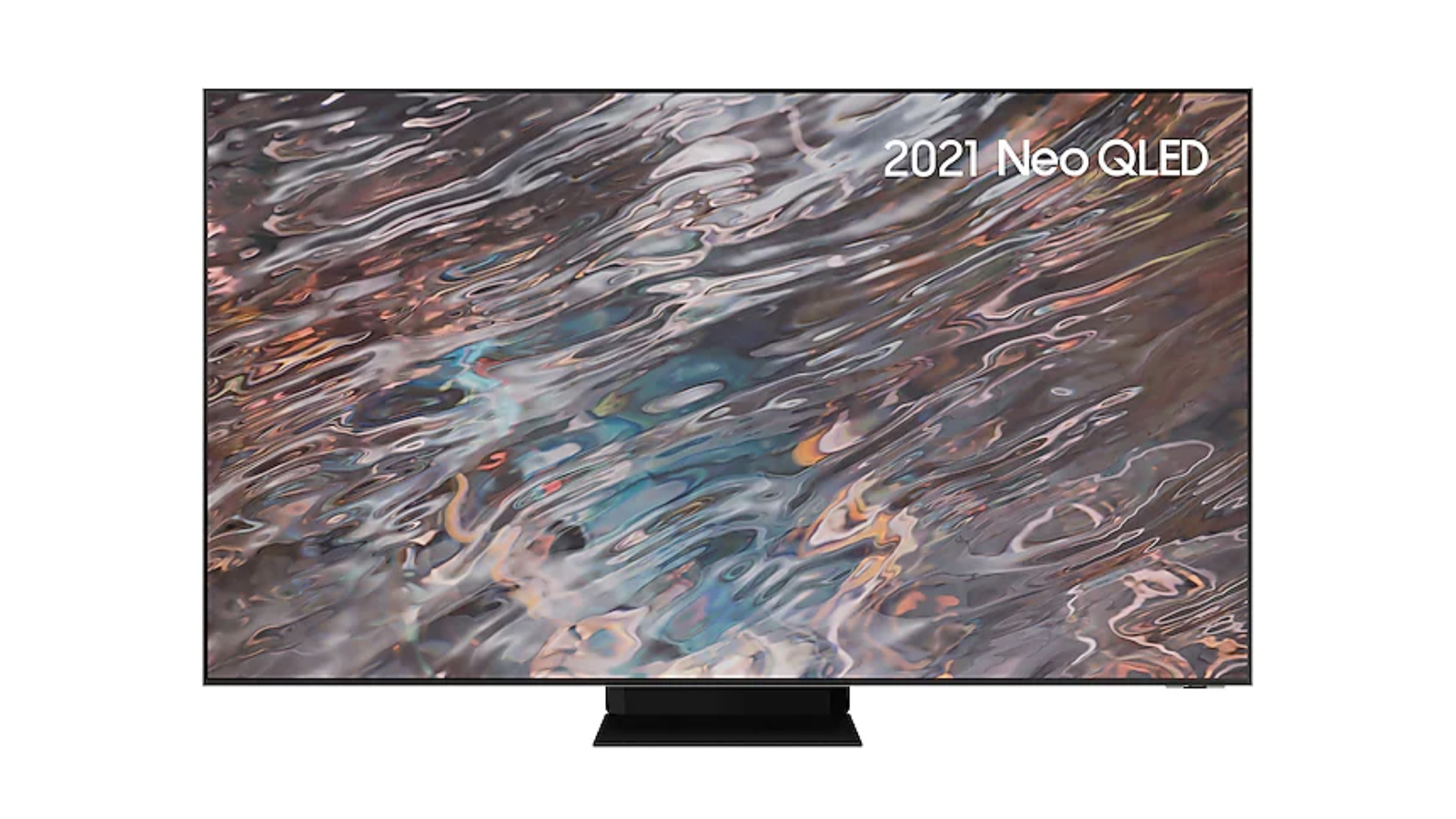
As mentioned above, the QN94A is the same as the QN95A but without One Connect. It therefore has just one HDMI 2.1 socket rather than four. We believe this is identical to the US and Australian version of the QN90A which, confusingly, is different to the UK QN90A.
Interestingly, unlike the QN95A, the QN94A is available as a 50-inch model. This version has a downgraded sound system compared to its larger siblings.
Samsung QN94A specs:
- Display type: Neo QLED
- Resolution: 4K
- Sizes: 50-inch, 55-inch, 65-inch, 75-inch, 85-inch
- One Connect: Yes
- Sound: OTS+ (OTS Lite for 50-inch model)
- 4K@120Hz: Yes
- Ultra-Wide Viewing Angle: Yes
- Anti-Reflective Panel: Yes
- HDMI 2.1 sockets: 1
Samsung QN94A prices:
- QE50QN94A – £1899
- QE55QN94A – £2099
- QE65QN94A – £2899
- QE75QN94A – £3999
- QE85QN94A – £5499
Samsung QN90A 4K Neo QLED TV (US and Australia)
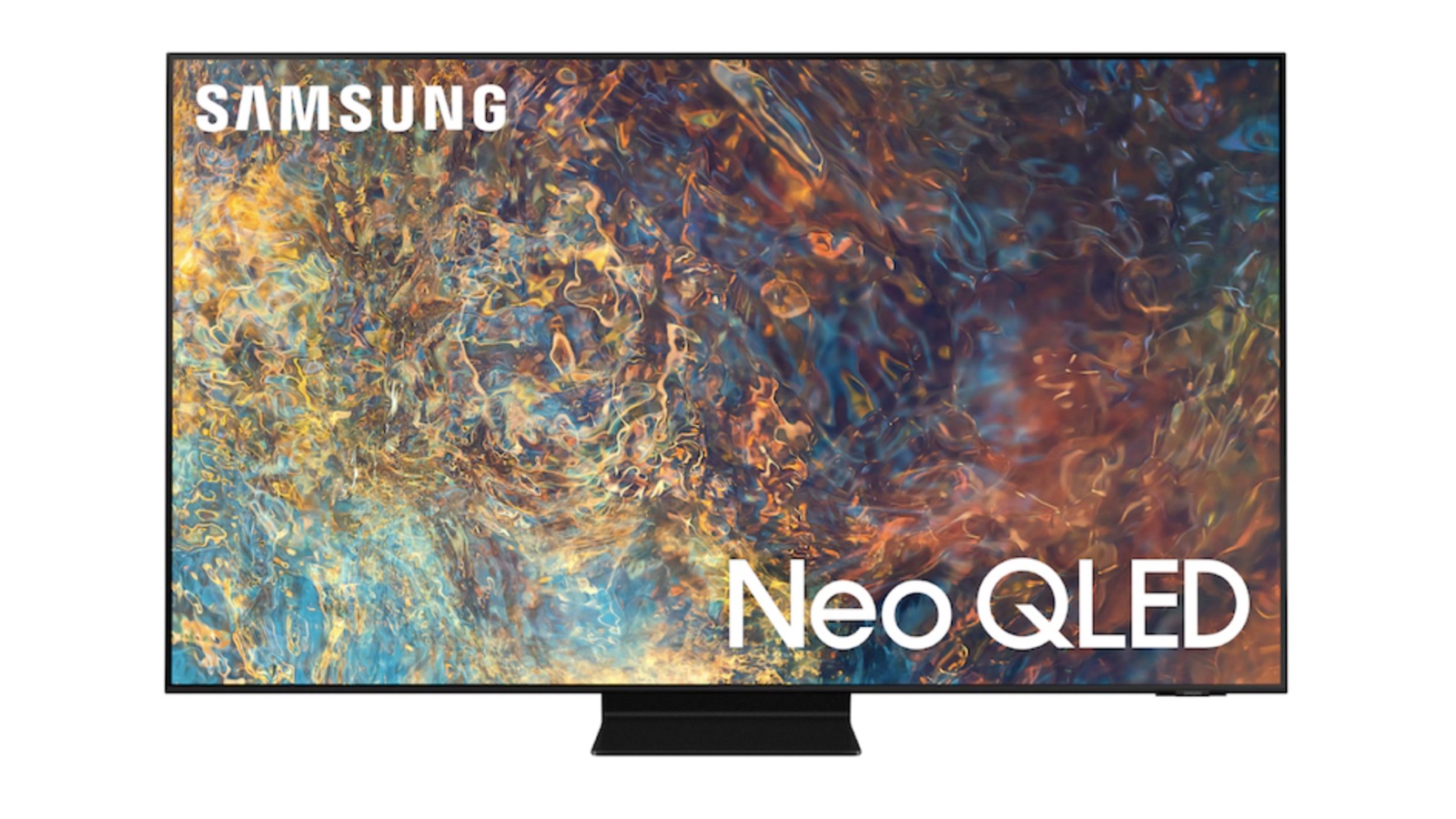
This is the top 4K Samsung TV for 2021. We understand that it's identical to the UK-exclusive QN94A, which means it's the same as the QN95A but without the One Connect box.
Samsung QN90A (US and Australia version) specs:
- Display type: Neo QLED
- Resolution: 4K
- Sizes: 50-inch, 55-inch, 65-inch, 75-inch, 85-inch (US-only)
- One Connect: No
- Sound: OTS+ (OTS Lite for 50-inch model)
- 4K@120Hz: Yes
- Ultra-Wide Viewing Angle: Yes
- Anti-Reflective Panel: Yes
- HDMI 2.1 sockets: 1
Samsung QN90A (US and Australia version) prices:
- QN50QN90A / QA50QN90A – $1500 / AU$2649
- QN55QN90A / QA55QN90A – $1800 / AU$3449
- QN65QN90A / QA65QN90A – $2600 / AU$4399
- QN75QN90A / QA75QN90A – $3500 / AU$5749
- QN85QN90A / QA85QN90A – $5000 / AU$TBC
Samsung QN90A 4K Neo QLED TV (UK version)
The UK version of the QN90A is very similar to the QN94A and its US/Aus namesake, but it appears to have a lower peak brightness rating and loses the Ultra Wide Viewing Angle tech.
Samsung QN90A (UK version) specs:
- Display type: Neo QLED
- Resolution: 4K
- Sizes: 50-inch, 55-inch, 65-inch
- One Connect: No
- Sound: OTS+ (OTS Lite for 50-inch model)
- 4K@120Hz: Yes
- Ultra-Wide Viewing Angle: No
- Anti-Reflective Panel: Yes
- HDMI 2.1 sockets: 1
Samsung QN90A (UK version) prices:
- QE50QN90A – £1799
- QE55QN90A – £1999
- QE65QN90A – £2799
Samsung QN85A 4K Neo QLED TV
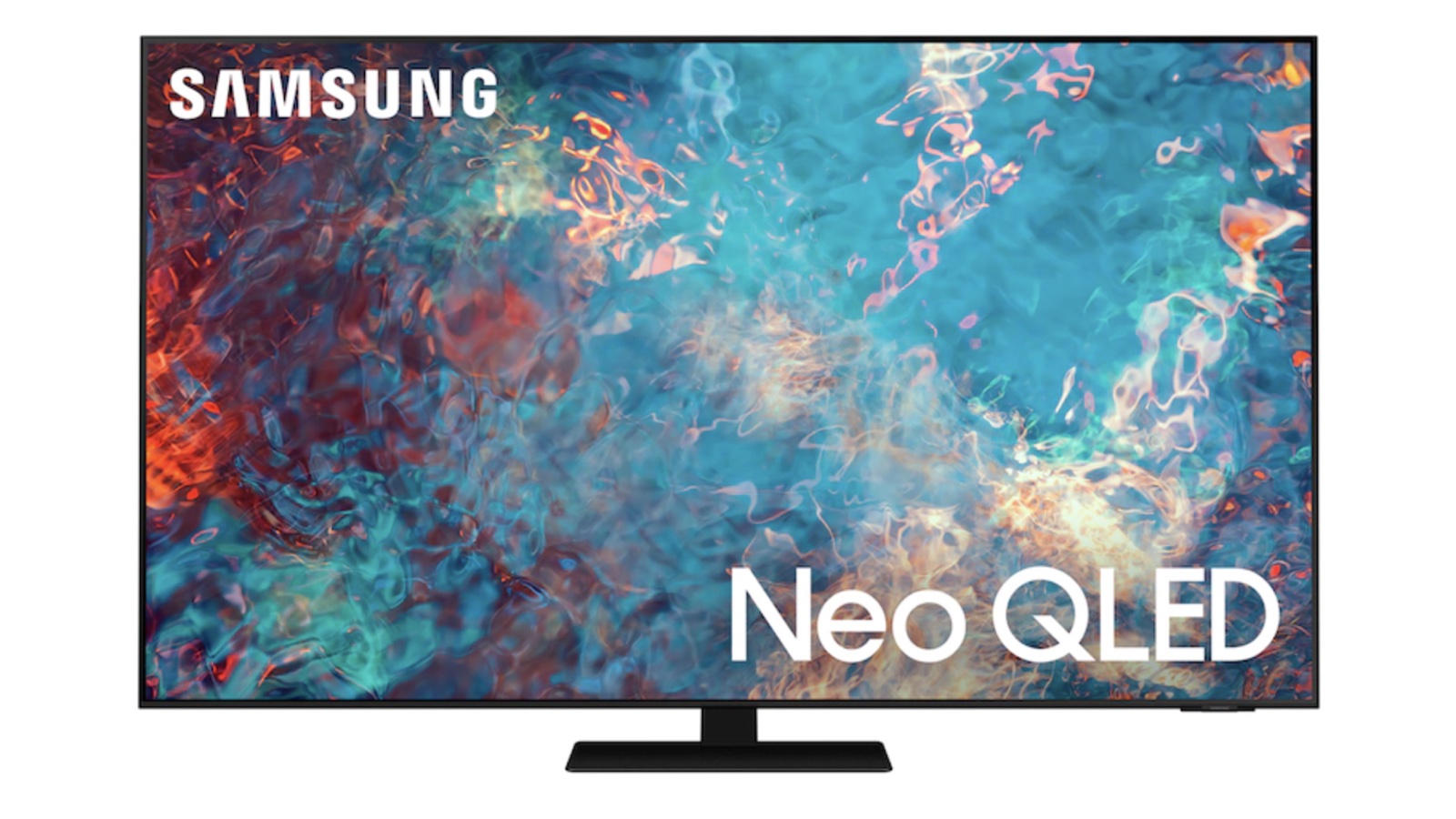
The entry-level Neo QLED model (i.e. the most affordable Mini LED model) in Samsung's 2021 range is the QN85A, which thankfully appears to be the same wherever you buy it.
It appears to have fewer dimming zones than the US and Australian QN90A, but we think that's the same number of zones as the UK QN90A. Compared to all versions of the model above it's got a more basic version of OTS sound with two fewer drivers.
The QN85A is just 25mm thick and has a stand with a 4mm bottom plate, although here it connects to the main chassis via a stalk or neck.
Samsung QN85A specs:
- Display type: Neo QLED
- Resolution: 4K
- Sizes: 55-inch, 65-inch, 75-inch, 85-inch
- One Connect: No
- Sound: OTS (2.2.2ch, 60W)
- 4K@120Hz: Yes
- Ultra-Wide Viewing Angle: No
- Anti-Reflective Panel: Yes
- HDMI 2.1 sockets: 1
Samsung QN85A prices:
- QE55QN85A / QN55QN85A / QA55QN85A – £1799 / $1600 / AU$3049
- QE65QN85A / QN65QN85A / QA65QN85A – £2499 / $2200 / AU$3999
- QE75QN85A / QN75QN85A / QA75QN85A – £3799 / $3000 / AU$TBC
- QE85QN85A / QN85QN85A / QA85QN85A – £4999 / $4500 / AU$6799
Samsung Q80A 4K QLED TV
You'll notice that this is the first model without an 'N' in its product number. That's because this isn't a Neo QLED, but instead the top QLED with a standard LED backlight.
Predictably, it's got far fewer dimming zones than its Mini LED-derived siblings and a thicker chassis, but it could still be a strong performance-per-pound option.
- Display type: QLED
- Resolution: 4K
- Sizes: 50-inch, 55-inch, 65-inch, 75-inch, 85-inch
- One Connect: No
- Sound: OTS (2.2.2ch, 60W)
- 4K@120Hz: Yes
- Ultra-Wide Viewing Angle: No
- Anti-Reflective Panel: No
- HDMI 2.1 sockets: 1
Samsung Q80A pricing:
- QE50Q80A / QN50Q80A / QA50Q80A – £1299 / $1200 / AU$TBC
- QE55Q80A / QN55Q80A / QA55Q80A – £1399 / $1300 / AU$2399
- QE65Q80A / QN65Q80A / QA65Q80A – £1999 / $1700 / AU$3149
- QE75Q80A / QN75Q80A / QA75Q80A – £2799 / $2600 / AU$TBC
- QE85Q80A / QN85Q80A / QA85Q80A – £TBC / $3700 / AU$TBC
Samsung Q70A 4K QLED TV
The Q70A appears towards the bottom of Samsung's 2021 QLED range, but it still boasts a 25mm-thick design and native support for 4K@120Hz.
Samsung's video presentation included images of it and the Q60A mounted on a variety of different stands, including a central pedestal/neck, a plate with two legs, and feet that can be placed at different widths and even raised to accommodate a soundbar, but it’s not clear which stand comes in the box with which model.
- Display type: QLED
- Resolution: 4K
- Sizes: 55-inch, 65-inch, 75-inch, 85-inch
- One Connect: No
- Sound: OTS Lite
- 4K@120Hz: Yes
- Ultra-Wide Viewing Angle: No
- Anti-Reflective Panel: No
- HDMI 2.1 sockets: 1
Samsung Q70A pricing:
- QE55Q70A / QN55Q70A / QA55Q70A – £1199 / $1300 / AU$1999
- QE65Q70A / QN65Q70A / QA65Q70A – £1499 / $1700 / AU$2499
- QE75Q70A / QN75Q70A / QA75Q70A – £2399 / $2600 / AU$TBC
- QE85Q70A / QN85Q70A / QA85Q70A – £3499 / $3700 / AU$5249
Samsung Q60A 4K QLED TV
Samsung's entry-level QLED model, the Q60A, will be available in more sizes than any other, and is the only one that comes in a 43-inch version.
The big spec downgrade is to the HDMIs, as there's no HDMI 2.1 socket here. That means there's no 4K@120Hz or VRR support, but ALLM and eARC do feature, and the new Motion Xcelerator Turbo tech is designed to give a 120Hz-like experience despite the 60Hz panel.
- Display type: QLED
- Resolution: 4K
- Sizes: 43-inch, 50-inch, 55-inch, 60-inch, 65-inch, 70-inch, 75-inch, 85-inch
- One Connect: No
- Sound: OTS Lite (2ch, 20W)
- 4K@120Hz: No
- Ultra-Wide Viewing Angle: No
- Anti-Reflective Panel: No
- HDMI 2.1 sockets: 0
Samsung Q60A pricing:
- QE43QN60A / QN43QN60A / QA43QN60A – £749 / $600 / AU$TBC
- QE50QN60A / QN50QN60A / QA50QN60A – £899 / $700 / AU$TBC
- QE55QN60A / QN55QN60A / QA55QN60A – £999 / $850 / AU$1599
- QE60QN60A / QN60QN60A / QA60QN60A – £TBC / $1000 / AU$TBC
- QE65QN60A / QN65QN60A / QA65QN60A – £1299 / $1100 / AU$1999
- QE70QN60A / QN70QN60A / QA70QN60A – £TBC / $1350 / AU$TBC
- QE75QN60A / QN75QN60A / QA75QN60A – £1999 / $1500 / AU$2599
- QE85QN60A / QN85QN60A / QA85QN60A – £2999 / $2800 / AU$4199
Samsung AU9000 4K LCD TV
Samsung's top LCD model, the AU9000 obviously lacks the quantum dots of its QLED siblings, but it seems to be pretty well-specced otherwise.
For starters, it boasts what Samsung is calling an 'AirSlim' design, which results in a depth measurement if just 25mm. The company's achieved this by developing a new backlight structure with almost no gap between the LEDs and LCDs, and by utilising physically smaller video and power components.
As mentioned above, the new Motion Xcelerator Turbo tech is designed to deliver a 4K@120Hz-like experience despite the set's native refresh rate being 60Hz. It also gets OTS Lite, which adds two virtual speakers that add height to the sound produced by the two physical speakers along the bottom.
- Display type: LCD
- Resolution: 4K
- Sizes: 43-inch, 50-inch, 55-inch, 65-inch, 75-inch, 85-inch
- One Connect: No
- Sound: OTS Lite
- 4K@120Hz: Native 60Hz with Motion Xcelerator Turbo support
- Ultra-Wide Viewing Angle: No
- Anti-Reflective Panel: No
Samsung AU8000 4K LCD TV
It's not at all clear at this stage how the AU8000 differs from the AU9000 above. We know that it features the same AirSlim design, and it appears to feature Motion Xcelerator Turbo and OTS Lite. It may just come down to the finish. We'll update when we get more information from Samsung.
- Display type: LCD
- Resolution: 4K
- Sizes: 43-inch, 50-inch, 55-inch, 65-inch, 70-inch, 75-inch, 85-inch
- One Connect: No
- Sound: 20W
- 4K@120Hz: Native 60Hz with Motion Xcelerator Turbo support
- Ultra-Wide Viewing Angle: No
- Anti-Reflective Panel: No
Samsung AU7100 4K LCD TV
The AU7100 appears to be very similar to the AU9000 and AU8000 except for a downgrade from Dynamic Crystal Colour to Pur Colour.
- Display type: LCD
- Resolution: 4K
- Sizes: 43-inch, 50-inch, 55-inch, 58-inch, 65-inch, 70-inch, 75-inch, 85-inch
- One Connect: No
- Sound: 20W
- 4K@120Hz: TBC
- Ultra-Wide Viewing Angle: No
- Anti-Reflective Panel: No
Tom Parsons has been writing about TV, AV and hi-fi products (not to mention plenty of other 'gadgets' and even cars) for over 15 years. He began his career as What Hi-Fi?'s Staff Writer and is now the TV and AV Editor. In between, he worked as Reviews Editor and then Deputy Editor at Stuff, and over the years has had his work featured in publications such as T3, The Telegraph and Louder. He's also appeared on BBC News, BBC World Service, BBC Radio 4 and Sky Swipe. In his spare time Tom is a runner and gamer.

